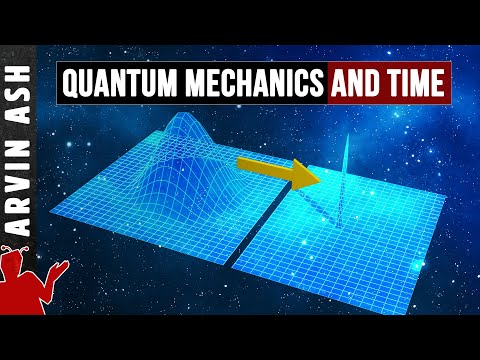How Quantum Mechanics produces REALITY & perhaps ARROW of TIME
How does the indeterminate world of quantum mechanics, where the future isn’t fixed, become the classical predictable real world we experience? Quantum researchers argue about it even today. It’s really all about time, and the boundary between the past and future.
Quantum mechanics insist that the spin of particle has neither one direction or the other until we look. The very act of looking forces the universe to make a choice.
All the variables that characterize the properties of an elementary particles, such as its position and momentum, are encoded in a mathematical expression called a wave function. It is just a sum of the states that the particle could be found in. This is called a superposition.
By itself, the wave function doesn’t have any intuitive meaning. But the square of the wave function gives us the probability of finding that quantum object in any particular place. Prior to measurement, quantum mechanics doesn’t really tell us anything about a particle. We know this is true because particles interfere with each other prior to measurement as in the double slit experiment.
In our macro world, we never see this superposition. So quantum physicists have to add in this transition from quantum to classical step by hand, as something extra to quantum mechanics, ThisIt is often called the “collapse” of the wave function, and was first introduced by the Hungarian mathematical physicist John von Neumann.
A better description of this is decoherence. This is how it works: The quantum state of a particle becomes mixed up – or entangled – with the states of the atoms in the environment. If the particle is in a superposition, this superposition then spreads to the atoms it interacts with. The come these entangled particles interact with, the farther this entanglement spreads until it spreads all across the universe. This leads to decoherence, because not the original particle becomes unrecognizable.
But the problem with decoherence is that in theory there is no end tot he entanglement or spreading of this quantumness. So in principle the superposed state of the original particle could be reconstituted if we could keep track of all the entanglement of all the particles.
But this would be like reversing time. Experiments in “recoherence” has been done however. This would mean undoing the measurement, and erasing any information we gained about it.
So here’s the question: Is there ever a point where the measurement process switches from being fully reversible in principle by this sort of recoherence, and becomes irreversible? Is there a point of no return?
Quantum experts don’t agree about this. As long as the process is reversible, it’s still quantum. It’s only when it becomes irreversible that it becomes classical – and it’s only then that we can truly say “what happened” – when reality becomes real.
Physicist Lee Smolin has suggested that this is in fact what distinguishes the past from the present. The past is classical. The present is quantum. What separates them is whether they are reversible or not, whether they have become known or not. Quantum mechanics may link knowledge, information, and time.
According to Smolin, It’s the change from a quantum, indefinite present to a classical, definite past that defines the very arrow of time itself, pointing it always in the forwardin one direction as the quantum present constantly churns out a classical past.
The past goes away. It is already known. But the future is all possibility. We can never go back – we can’t change the past. In fact, the past no longer really exists at all. “Once something is definite”, says Smolin, “its job is done and it is gone.”
But what happens to all those futures that aren’t selected by the decohering present? Where do those alternative possible futures go? Do they pop up in an alternative universe? Or is there just one reality?
Do not forget to share your opinion with us to provide you with the best posts !




0 Comments